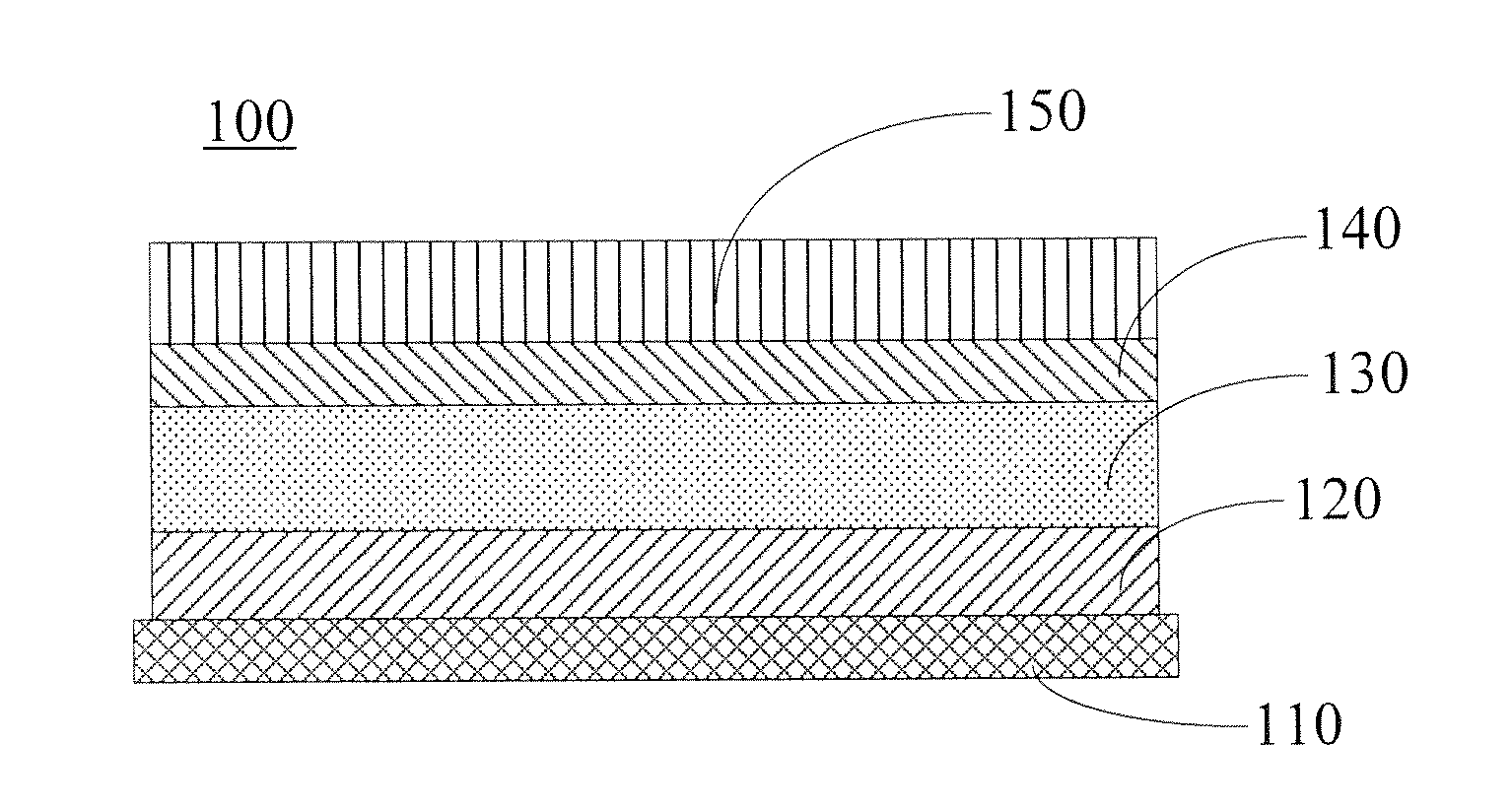Polymer solar cell and method for preparing same
a solar cell and polymer technology, applied in the field of solar cells, can solve the problems of affecting the service life of the device, low open circuit voltage and photoelectric conversion efficiency of solar cells, etc., and achieve the effects of simple doping process, stable, and inexpensiv
- Summary
- Abstract
- Description
- Claims
- Application Information
AI Technical Summary
Benefits of technology
Problems solved by technology
Method used
Image
Examples
example 1
[0051]The polymer solar cell has a structure of ITO / ZnO:Li2CO3 / P3HT: PCBM / LiF / Al.
[0052]The preparation process is described as follows:
[0053]The ITO was photoetched and cut into pieces with required size, the anode conductive substrate was then treated using ultrasonic sequentially in detergent, deionized water, acetone, ethanol, and isopropyl alcohol each for 15 minutes to remove impurities on the surface of the ITO, respectively. The conductive substrate was surface-treated using oxygen plasma for 5 minutes after cleaning; the power was 10W.
[0054]The hole buffer layer with a thickness of 60 nm was formed on the surface of the ITO by electron beam technology, in which, ZnO was used as a host and Li2CO3 was used as a dopant guest, a mass ratio of Li2CO3 to ZnO was 6%.
[0055]The chlorobenzene solution of the mixture of P3HT and PCBM was then spin-coated on the hole buffer layer, and dried at a temperature of 100° C. for 30 minutes to form the active polymer layer with a thickness of 1...
example 2
[0061]The polymer solar cell has a structure of IZO / ZnS:Li2O / MEH-PPV:PCBM / CsF / Ag.
[0062]The preparation process is described as follows:
[0063]The IZO was photoetched and cut into pieces with required size, the anode conductive substrate was then treated using ultrasonic sequentially in detergent, deionized water, acetone, ethanol, and isopropyl alcohol each for 15 minutes to remove impurities on the surface of the IZO, respectively. The conductive substrate was surface-treated using oxygen plasma for 10 minutes after cleaning; the power was 50W.
[0064]The hole buffer layer with a thickness of 100 nm was formed on the surface of the IZO by magnetron sputtering process, in which, ZnS was used as a host and Li2O was used as a dopant guest, a mass ratio of Li2O to ZnS was 10%.
[0065]The xylene solution of the mixture of MEH-PPV and PCBM was then spin-coated on the hole buffer layer. and dried at a temperature of 70° C. for 100 minutes to form the active polymer layer with a thickness of 30...
example 3
[0068]The polymer solar cell has a structure of FTO / CdS:LiCl / MDMO-PPV:PCBM / LiF / Au.
[0069]The preparation process is described as follows:
[0070]The FTO was photoetched and cut into pieces with required size, and the anode conductive substrate was then treated using ultrasonic sequentially in detergent, deionized water, acetone, ethanol, and isopropyl alcohol each for 15 minutes to remove impurities on the surface of the FTO, respectively. The conductive substrate was surface-treated using oxygen plasma for 15 minutes after cleaning; the power was 30W.
[0071]The hole buffer layer with a thickness of 10 nm was formed on the surface of the FTO by electron beam technology, in which, CdS was used as a host and LiCl was used as a dopant guest, a mass ratio of LiCl to CdS was 1%.
[0072]The chlorobenzene solution of the mixture of MDMO-PPV and PCBM was spin-coated on the hole buffer layer, and dried at a temperature of 200° C. for 10 minutes to form the active polymer layer with a thickness of ...
PUM
| Property | Measurement | Unit |
|---|---|---|
| thickness | aaaaa | aaaaa |
| thickness | aaaaa | aaaaa |
| thickness | aaaaa | aaaaa |
Abstract
Description
Claims
Application Information
 Login to View More
Login to View More - R&D
- Intellectual Property
- Life Sciences
- Materials
- Tech Scout
- Unparalleled Data Quality
- Higher Quality Content
- 60% Fewer Hallucinations
Browse by: Latest US Patents, China's latest patents, Technical Efficacy Thesaurus, Application Domain, Technology Topic, Popular Technical Reports.
© 2025 PatSnap. All rights reserved.Legal|Privacy policy|Modern Slavery Act Transparency Statement|Sitemap|About US| Contact US: help@patsnap.com



